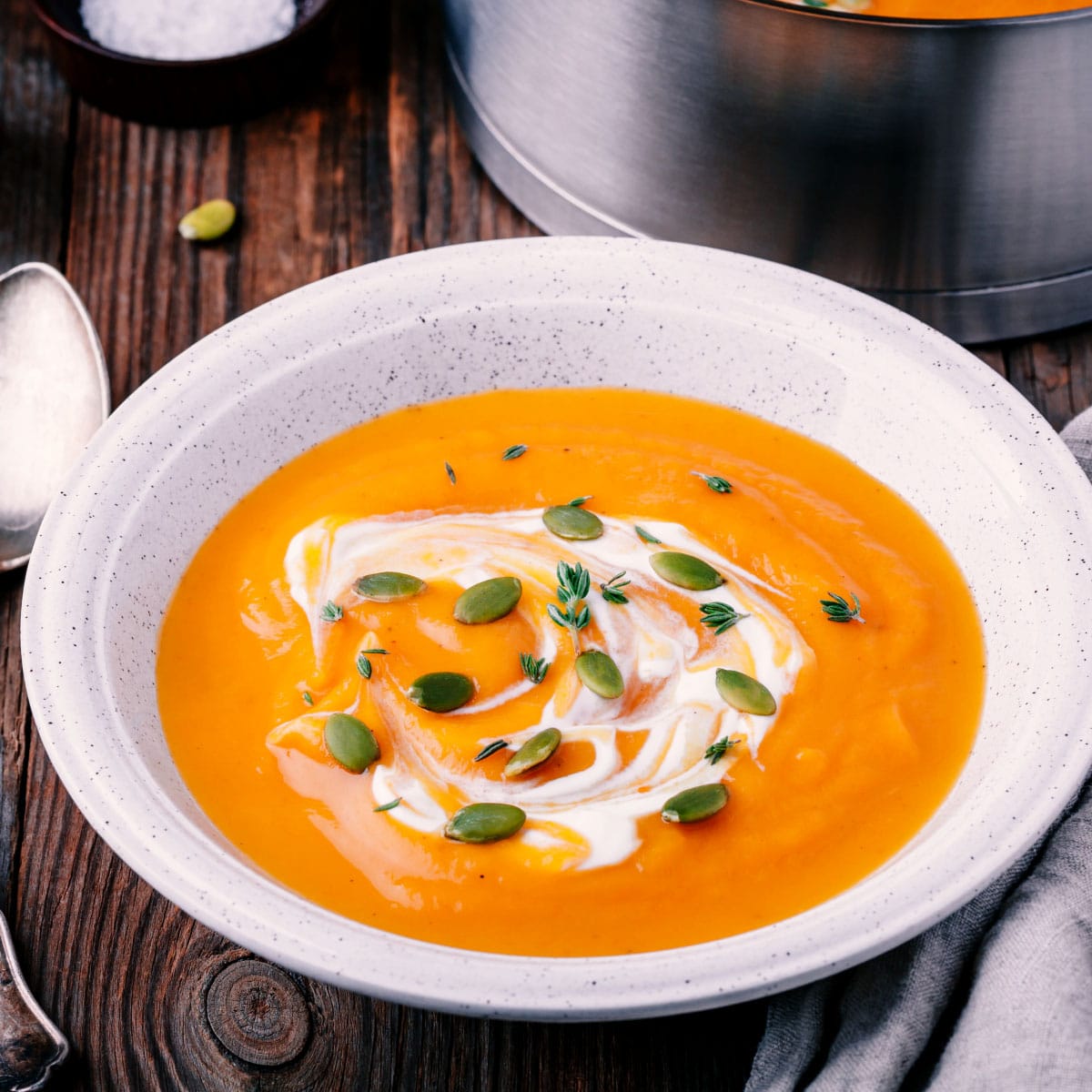Can you microwave sour cream? Everyone seems to have an opinion about this question. Some say you can't microwave sour cream, while others claim it's perfectly safe. So what's the truth? Can you microwave sour cream or not? Let's take a look at the facts.
- Each type of sour cream reacts differently with heat, so what kind you use matters.
- Heat the sour cream in short bursts. Don't try to heat it all at once, or you'll end up with a big mess.
- Use a spoon to stir the sour cream occasionally while it's heating. This will help prevent hot spots and splattering.
Jump to:

Choose a sour cream that fits your needs.
As a first step, before heating sour cream, you need to identify what kind of sour cream you have - not all types are microwaveable. The type you choose will make a difference in the heating process and the results.
Why can not all types of sour cream be microwaved?
The answer has to do with the types of fats that are present in sour cream. Some types of sour cream have higher fat content than others. The higher the fat content, the less likely the sour cream will curdle or separate when heated.
On the other hand, lower-fat varieties of sour cream are more likely to curdle or separate when heated. Why is that? It has to do with the amount of milk fat in the sour cream. The higher the milk fat content, the more stable the sour cream will be when heated.
So, if you want to avoid a watery mess, only microwave sour cream that is labeled full-fat because it has a higher fat content. The fat helps stabilize the clumps, so they don't separate when heated but will also add richness and creaminess to your dish.
Read:
What are the different types of sour cream?
1 Regular or full-fat sour cream:
This is the most common sour cream, containing around 18-20% milk fat. It's thick, creamy, and has a rich flavor. If you have a tub of sour cream, it's likely the full-fat variety. This is the best type to use for recipes since it doesn't separate as easily and holds its shape well.
2 Reduced fat or light sour cream:
This sour cream contains about half the amount of milk fat as regular sour cream. It's slightly thinner in consistency but still has a good flavor. Light or reduced-fat sour cream can also be microwaved, but it may not give you the same results in recipes.
3 Nonfat or fat-free sour cream:
This is the lowest-fat option and contains less than 1% milk fat. It's thinner than both reduced-fat and regular sour cream and has a milder flavor. The fat-free version is not suitable for cooking since it will curdle when heated.
So, Can you microwave sour cream?
Yes, you can microwave sour cream. Regular or full-fat sour cream is the best type of sour cream to use since it's less likely to curdle when heated.
Just be sure to heat it on low or medium power to avoid curdling. Be careful not to overheat it. If you do, it will start to break down. To avoid this, warm it gently or add a little milk if it's too thick. Don't let the mixture come to a boil.
Sour cream is made up of milk solids and cream. Heating full-fat sour cream will help to thicken the sauce and prevent it from curdling. The higher fat content will also help to balance out the acidity in the dish.
When heating sour cream in the microwave
Microwave allows you to control the intensity and time of heating, so it is possible to heat sour cream without curdling.
Step by step on how to microwave sour cream:
- Put the sour cream in a microwave-safe container.
- Cover the container with a lid or plastic wrap.
- Vent the lid or plastic wrap so that steam can escape.
- Microwave the sour cream on low power and heat it in a short burst for a 10-second increment, stirring every interval.
- Check the temperature of the sour cream before using it. If it's not warm enough, microwave it for an additional 5 seconds.
- Whisk in milk or water if the sour cream starts to curdle.
Note:
Sour cream is an emulsion of butterfat in water. When you heat it, the butterfat can separate from the water. If you heat it too quickly or at too high a temperature, the butterfat will separate into clumps. This process is called curdling. But if you heat it slowly and at a lower temperature, the butterfat will stay suspended in the water. That's why you can microwave sour cream without curdling it.
Why is full-fat sour cream best?
When it comes to microwave cooking, full-fat sour cream is your best bet over low-fat or nonfat options. The higher fat content will help to stabilize the clumps, so they don't separate when heated. This will also add richness and creaminess to your dish.
To avoid a watery mess, only microwave sour cream for a short time. Cook it on 50% power for 10 to 15-second intervals, stirring in between each burst of heat. This will help to distribute the heat and prevent separation evenly. When milk solids are heated too quickly, they can curdle and spoil the taste of your dish.
So, if you're looking for the best results, go with full-fat sour cream when microwaving. Just be sure to watch it closely and stop the cooking process as soon as it's heated through.
What are the uses of heated sour cream?
Heated sour cream can be used as a condiment, in dips, or as an ingredient in baked goods. It can also be used to top off a dish or to add creaminess to a recipe. Some people also enjoy eating heated sour cream as a snack. Consider trying heated sour cream to add extra flavor to your food. You may be surprised at how much this simple change can enhance your meals.
1 Add it to your favorite condiments.
Consider adding heated sour cream to your next batch if you are a ketchup, mayo, or BBQ sauce fan. Add a dollop of sour cream to your ketchup, mayo, or BBQ sauce and stir until combined. This will give these condiments a new creaminess and depth of flavor.
2 Make a flavorful dip.
Dips are always a hit at parties and gatherings. If you want to take your dip game up a notch, try adding heated sour cream to your next recipe. This will give the dip a richer flavor and creamier texture.
3 Use it in baked goods.
Add heated sour cream to your favorite cakes, cookies, or muffins for an extra dose of flavor. The sour cream will add moisture and depth of flavor to your baked goods.
4 Top off a dish.
If you want to dress up a simple dish, try adding a dollop of heated sour cream. This will add creaminess and flavor to any dish.
5 Add creaminess to a recipe.
If you want to add creaminess to a recipe without adding dairy, try using heated sour cream. This will give the dish a rich flavor and creamy texture.
6 Enjoy it as a snack.
If you want a satisfying snack, try eating heated sour cream alone. This will give you a creamy and flavorful snack that will tide you over until your next meal.
How about heating it with other ingredients?
Adding sour cream to other ingredients and then microwaving is usually fine. Because the other components will help to distribute the heat evenly, preventing the sour cream from getting too hot too quickly. This is especially true if you're microwaving a soup or sauce that already has liquid in it.
Just be sure to stir the sour cream into the hot mixture until it's evenly combined. And don't forget to add a dollop of sour cream to your finished dish before serving!
Troubleshooting sour cream that's been microwaved
If your sour cream has a runny consistency or looks curdled after being microwaved, there are a few things you can do to try and fix it.
- First, whisk the sour cream vigorously to see if that helps thicken it up. If not, you can try heating it in short bursts in the microwave until it reaches the desired consistency.
- Finally, add a thickening agent such as cornstarch or gelatin to the sour cream and stir until combined before microwaving it again.
If your sour cream is still not salvageable, you can try using Greek yogurt as a substitute in recipes. While it won't taste exactly the same, Greek yogurt has a similar consistency and can be used in most recipes that call for sour cream.
How to prevent sour cream from curdling
When heated in the microwave:
Sour cream can curdle if it is not prepared correctly. If you want to prevent it from curdling, you can do a few things.
- First, use a low-power setting on your microwave and heat the sour cream in a microwave-safe bowl in short bursts.
- Stir well after each burst to help the sour cream heat evenly.
- Do not let the sour cream come to a boil. If your sour cream does curdle, it can still be used in recipes, but it will not have the same creamy texture.
How about heating sour cream on the stovetop?
When heating sour cream on the stovetop, be sure to whisk it frequently and slowly bring it up to temperature. Adding a bit of flour or cornstarch can also help to prevent curdling. Finally, don't let the sour cream boil. Once it reaches a simmer, remove it from the heat.
Choose the full-fat variety of sour cream for the best results when cooking. Lower-fat versions are more likely to curdle. Check the temperature of the soup, sauce, or another dish before adding the sour cream. If it's too hot, the sour cream will curdle. only add the sour cream once the temperature is below 180° F. Slowly stir it into the hot dish, then let it cook for a few minutes more to allow the flavors to meld.
If your dish does curdle, don't despair.
1 Add a bit of milk
If curdling begins, remove the sour cream from the heat immediately and stir in a bit of milk. This will help to smooth out the texture and prevent further curdling.
2 Use a blender or immersion blender to smooth out the clumps.
An immersion blender is ideal for this task because it can easily blend the sour cream and make it smooth without transferring it to a different container. Plus, it's easy to clean!
3 You can also strain the dish through a fine mesh strainer.
You know how frustrating it can be if you've ever heated a bowl of soup or sauce only to find that the dairy has clumped up and separated. Strainers are great for removing any lumps or clumps from your dish so you can enjoy a smooth, creamy final product.
Note:
The resulting mixture might not be as smooth as you'd like, but it will still be tasty. It is not essential to use it in recipes without a smooth texture, such as dips or sauces. Remember that curdled sour cream is still safe to eat. It might not be as pretty, but it will still taste good!
General guidelines for reheating sour cream:
- Heat the sour cream in a saucepan over low heat or on a low setting when using the microwave.
- Stir the sour cream frequently to help it heat evenly.
- Once the sour cream reaches around 140 degrees Fahrenheit, it is ready to use.
- Always follow the instructions for the specific recipe you're making. Keep in mind that these are only general guidelines. Heating times and temperatures may vary depending on the recipe you're using.
Common mistakes when heating sour cream
There are a few things to keep in mind when heating sour cream so that you don't end up with a runny, separated mess.
1 Avoid using too much heat.
If the sour cream is heated too quickly or at too high of a temperature, it can cause the fat and water content to separate. This can result in a runny, watery sour cream that isn't very pleasant to eat. To avoid this, heat the sour cream slowly and at a low temperature.
2 Not stirring it enough.
As the sour cream heats, stir it frequently as it is warming up. Heating the sour cream will cause the fat and water content to separate. The frequent stirring will help prevent the formation of hot spots and to redistribute those contents so that you end up with a smooth, consistent sour cream. If hot spots form, they can cause the sour cream to curdle.
3 Do not heat the sour cream for too long
The best way to reheat sour cream is slowly and at a low temperature, stirring frequently. Once it reaches the desired temperature, remove it from the heat so that it doesn't continue cooking and becomes too thick. The water evaporation can cause the sour cream to thicken and even become grainy.
Recipes that include sour cream
Sour cream can be used as a topping for many dishes or as a main ingredient in some recipes. It adds a delicious creamy flavor to food and can be used in sweet and savory dishes.
Try one of these recipes if you're looking for a new way to use sour cream. From cheesy potatoes to dips and cheesecake, there's something for everyone.
1 Cheesy potato:
This recipe is a great side dish or main course. Simply bake some potatoes and top them with sour cream, cheese, and green onions.
2 Dips:
There are many different ways to make dips using sour cream. Try adding it to guacamole or ranch dressing for a creamy twist.
3 Cheesecake:
This rich and creamy dessert is made even better with the addition of sour cream. Try topping it with fresh fruit for a truly decadent treat.
Why add sour cream? There are a few reasons. First, sour cream adds a lovely tang to the cheesecake, balancing the sweetness. Second, it makes the cheesecake ultra-smooth and creamy. Finally, it helps to prevent cracks in the cheesecake as it bakes. All of these factors come together to create a truly wonderful cheesecake.
4 Enchiladas:
There are many reasons why sour cream is the best choice for enchiladas. First, it adds a delicious creamy flavor to the dish. Second, it helps to thicken the sauce and prevents it from being too runny. And third, it gives the enchiladas a nice, firm texture.
5 Chili:
This recipe is not complete without a dollop of sour cream on top. It adds creaminess and depth of flavor to the dish. Sour cream is a good topping on chili because it adds creaminess and depth of flavor to the dish. The sour cream helps balance the chili's spice and makes it more flavorful. Additionally, the sour cream adds a layer of creaminess that helps to make the chili more filling and satisfying.
6 Soup:
Sour cream can be a great addition to soup. It can add richness and creaminess, and it can also help to thicken the soup. If you want a dairy-free option, you can use coconut milk.
7 Taco soup:
Sour cream adds a delicious richness and creaminess to this taco soup recipe. It also helps to thicken the soup slightly, making it even more comforting and satisfying. If you're looking for a dairy-free option, you could try using coconut milk.
8 Tater tot casserole:
Sour cream is a good topping for tater tots casserole because it adds a creamy, tangy flavor. It also helps to keep the soup moist. You can use nonfat Greek yogurt instead of sour cream if you want a healthier option.
9 Burritos:
Sour cream is a good topping for burritos because it is creamy and flavorful. It can also help to balance out the flavors of the other ingredients in the burrito. Sour cream can also help keep the burrito filling moist and prevent it from drying.
10 Quesadillas:
Quesadillas are basically just tortillas and cheese; it adds creaminess, body, and a bit of tang. The sour cream adds some much-needed moisture; quesadillas can be a bit dry without it.
11 Nachos:
Sour cream is a common condiment for nachos. It can add creaminess, tanginess, and depth of flavor to the dish. While some people might find the taste of sour cream overwhelming, others may enjoy the contrast it provides to the spices in the nachos.
If you're looking for a dairy-free option, you can try substituting Greek yogurt or avocado. Both of these options will add creaminess to the nachos without the dairy.
How to store sour cream so that it lasts longer
Storing sour cream to extend its shelf life really comes down to two things: temperature and air. You'll want to keep sour cream in the coldest part of your fridge and an airtight container. A Mason jar or a plastic tub with a lid works well.
If you find that your sour cream has started to form a thick layer on the top, give it a good stir before using it. As long as the sour cream isn't lumpy or discolored, it should be fine to use.
Sour cream can last in the fridge for up to two weeks, but it's best to use it within the first week for optimal freshness. After that, it can start to develop an off-flavor.
How to tell sour cream goes bad.
Like any food product, sour cream requires proper storage to remain edible, and a key aspect is knowing when it is no longer edible. Here are some signs to look for, but first, you need to have a bit of background knowledge. Check for more information here on what they mean.
A little bit of knowledge about food safety:
Step 1
Know when to use sour cream by identifying whether it is "sell by," "best if used by," or "use by."
"Sell by" date:
As per USDA, the "sell by" date stipulates when the store should no longer sell a product. This means the store is no longer liable for the quality of the product once it has been sold.
"Best if used by (or before)" date:
The "best if used by (or before)" date is recommended for the best flavor or quality. It is not a safety date except for when used on infant formula, as per USDA.
The food quality deteriorates after the date passes, but it may still be safe to eat if stored properly. The food may not have the best flavor or texture, but it would not pose a health risk if consumed.
The "use by" date:
The "use by" date is the last date recommended for production while at peak quality. The manufacturer of the product has determined the date. It's important to remember that food products are often good for a time after the date on the package as long as they are appropriately stored.
Step 2
Observe the "best if used by" date with care. Sour cream is generally safe in the refrigerator if it is unopened. Once you open the container, it will stay safe to eat. However, you should finish the sour cream seven to 10 days after the "best if used by" date.
I emphasize the operative word: "will stay safe," meaning that though the quality may have changed, it will still be safe to eat. After 10 days, you should toss it.
Give it a sniff if you're unsure whether your sour cream has gone bad. Fresh sour cream should have a mild, slightly tangy smell. If it smells sour, rancid, or otherwise off, it's time to toss it.
If a tub of sour cream has been left on a counter at room temperature for several hours, bacteria can fester, and it will not be safe to eat, no matter what the "best if used by" date.
Step 3
Remember this warning: There is no absolute expiration date ensuring that all products are safe to consume after the "best if used by" date. However, once that date passes, there is a potential that the sour cream will not be of its best quality. The change in quality is usually a total loss of flavor or texture, but there is also the potential for growing bacteria which can cause illness.
Bottom line: Consumers should rely on their common sense when deciding whether or not to consume a product past its "best if used by" date and follow safe food handling instructions.
Use Your Common Sense and Senses Together
1 Appearance:
You can tell if the sour cream is good by its appearance. You may find that the sour cream's surface is speckled with whey. Whey is normal in small amounts, but in abundance, it is not.
If the sour cream has changed colors or is otherwise discolored, it's best to discard it. The color change usually indicates spoilage, even if the sour cream doesn't smell or taste bad.
2 Smell:
The smell is the most telling sign that your sour cream has gone bad. If it smells rank or off, it's time to chuck it.
3 Taste:
Take a small spoonful of the sour cream and give it a taste. You can tell if it's sour or off by its taste.
4 Texture:
The texture of bad sour cream will be lumpy, watery, or otherwise not smooth. Good sour cream should be creamy and thick.
5 Mold:
Mold is another sure sign that your sour cream has gone bad. If you see mold growth, discard the entire container, even if there's only mold on the top layer—no ifs, and, or buts about it.
Bottom line:
If your sour cream has any of the above signs, it's best to discard it. However, if it tastes a little off, you can still use it in recipes where it will be cooked. Sour cream is relatively cheap, so it's not worth taking the risk of eating something that might make you sick.
How long does opened sour cream last in the fridge?
Once opened, sour cream will last in the fridge for about two weeks before beginning to spoil. However, if you notice any of the signs of spoilage listed above, it's best to discard the sour cream, even if it's within that two-week timeframe.
Can you freeze sour cream?
Yes, you can freeze sour cream! Just transfer it to an airtight container before popping it in the freezer. When frozen, sour cream will last for about six months.
Thawed sour cream may not be as thick or creamy as before freezing, but it will still be perfectly safe to eat. Use melted sour cream in baked goods or sauces, where its changed texture won't be as noticeable.
How do you use sour cream that's gone bad?
While you shouldn't eat bad sour cream on its own, there are some ways you can use it in some recipes if it's starting to go bad. Just taste the dish before serving it to ensure the sour cream flavor isn't too strong.
Here are some ideas for using sour cream that's starting to go bad:
Make sour cream pancakes:
This recipe for sour cream pancakes is delicious and only requires a few simple ingredients you probably already have on hand. If your sour cream is on the verge of going bad, why not put it to good use by making pancakes? Check the recipe here.
Use it in a savory dish:
Bad sour cream can still be used in savory dishes like this chicken enchilada casserole. The other ingredients' flavors will help mask any off-flavors in the sour cream.
Make a homemade facial mask:
If your sour cream has gone bad, don't despair! You can still use it to make a homemade facial mask. This mask is great for moisturizing and soothing dry, irritated skin.
Use it as a fertilizer:
Believe it or not, bad sour cream can actually be used as a fertilizer for your plants. The lactic acid in the sour cream will help increase the soil's acidity, which can benefit some plants.
Add it to scrambled eggs or omelets:
If you've got some bad sour cream that you need to use up, add it to your scrambled eggs or omelets. The eggs will help to mask the off-flavors of the sour cream.
Mix it with equal parts milk and make a ranch dressing:
Why make a ranch dressing if you need to use up some bad sour cream? This dressing is delicious and only requires a few simple ingredients that you probably already have on hand.
Make a sour cream coffee cake:
This recipe for the sour cream coffee cake is delicious and only requires a few simple ingredients you probably already have. The coffee cake will help to mask any off-flavors in the sour cream. Check the recipe here.
Add it to smoothies or milkshakes for a creamy flavor:
If you need to use some bad sour cream, add it to your smoothies or milkshakes. The other ingredients will help to mask any off-flavors in the sour cream.




